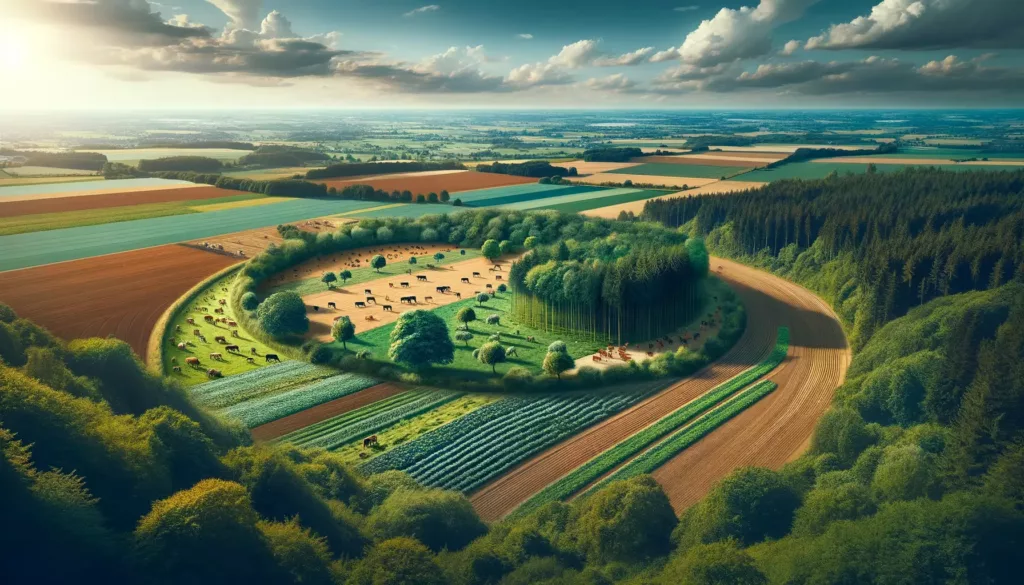Embracing Agroforestry for a Sustainable Future
Europe’s long-standing agricultural policies, favoring cropland and pastures over forests, have led to the loss of billions of trees. Facing the dual challenges of climate change and biodiversity loss, Europe is now committed to transforming its food systems. The aim is to reduce greenhouse gas emissions and increase sustainability, coupled with an ambitious goal to plant an additional 3 billion trees by 2030. However, achieving a sustainable food system that’s both lower in emissions and resilient to climate change requires a shift in perspective from forests to integrating trees in both urban and rural landscapes, particularly on farmlands.

Learning from the Global South
Tim Pagella, a senior lecturer in forestry at Bangor University in Wales, emphasizes the need for a landscape-scale perspective to achieve forest restoration goals. In Europe, the segregation of agriculture and forest policies has often left agroforestry neglected. Pagella, who collaborates with CIFOR-ICRAF in developing agroforestry programs, suggests that Europe could draw valuable insights from the Global South. Here, integrating trees with crops and livestock is a longstanding practice that supports ecosystems and farmers’ livelihoods, especially amid climate uncertainties. Anja Gassner, a science and policy adviser, stresses the importance of designing agroforestry systems that cater to the farmer’s needs and are suitable for the local context to ensure their success.
Recognizing ‘Trees Outside Forests’
Until recently, European agricultural subsidies favored land without trees. The 2019 European Green Deal, prioritizing sustainable food systems, marked a shift by recognizing the value of agroforestry. Although European farms often have trees in hedgerows and buffer areas, these are seldom acknowledged as part of productive agricultural systems. These ‘trees outside forests’ have also been excluded from carbon accounting, focusing only on forests. However, the updated Common Agricultural Policy (CAP) now acknowledges food production systems that integrate trees, crops, and livestock, encouraging practices like wood pastures, alley cropping, and urban home gardens.
Bridging the Gap Between Research and Practice
Despite the growing attention to agroforestry in Europe and research by groups like the European Agroforestry Federation (EURAF), there’s a notable disconnect between academic discussions and practical application. Gassner points out the need for more support and funding to enable farmers to fully utilize trees on their farms. Often, landscape restoration programs focus more on conservation than integrating trees into productive landscapes, requiring a balance between landowner productivity needs and conservation goals.
Strategies for Landscape Restoration
Approaches to achieving restoration goals vary. ‘Land sharing’ combines human activities with nature protection, like integrating forests with livestock. ‘Land sparing,’ on the other hand, involves setting aside natural areas for conservation. Successful implementation requires a holistic view of the landscape, ensuring agroforestry contributes to biodiversity and helps farmers adapt to climate change. For instance, in Wales, planting trees around river headwaters can help cool rising water temperatures, affecting ecosystems.
Drawing Inspiration from the Global South
European planners can learn from the Global South’s decades of agroforestry experience. Key principles include focusing on the farmer, tailoring interventions to specific farm characteristics, and creating synergies among crops, livestock, and trees. These principles have been effectively applied in various regions, from Uganda’s community seed banks to Vietnam’s tree incorporation in agricultural systems, and Brazil’s restoration efforts in the Cerrado and Caatinga ecosystems.
Pagella notes the multifaceted benefits of trees in landscape restoration but also acknowledges trade-offs, like losing ecosystem functions when trees are harvested for timber. Effective agroforestry design, therefore, includes various tree-based options to provide diverse benefits across the landscape.
